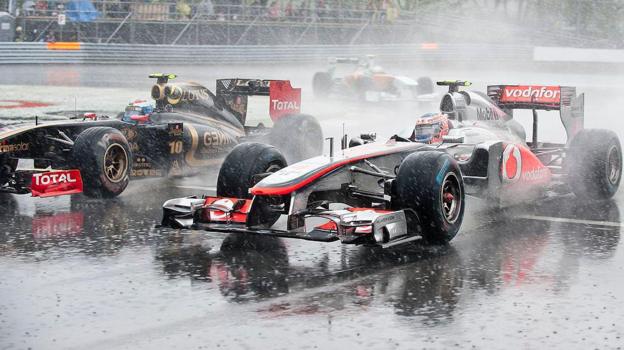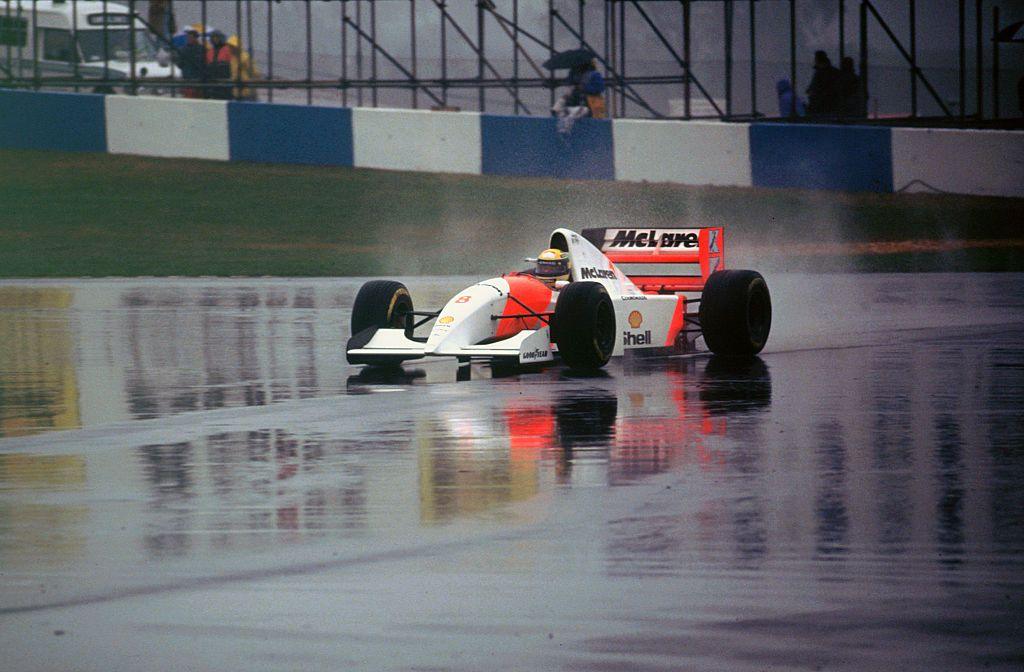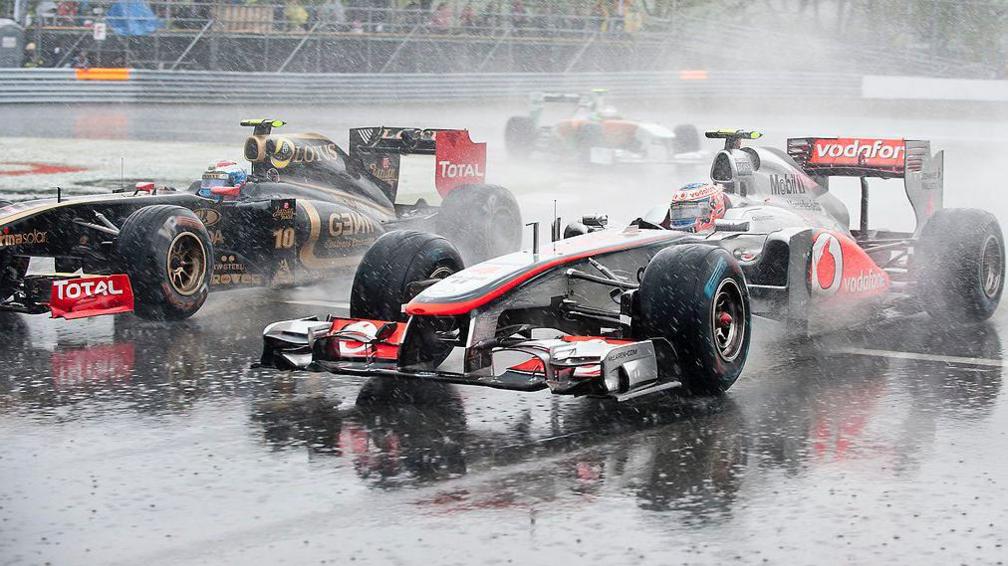Which was the greatest F1 wet-weather drive?
Ayrton Senna, Michael Schumacher, Lewis Hamilton and Max Verstappen have all mastered treacherous conditions to win F1 races – but which was the best?


Max Verstappen produced a superb drive to win the Sao Paulo Grand Prix on Sunday, coming through the field from 17th on the grid in treacherous conditions.
The Dutchman described it as “definitely the best” of his 62 Formula 1 grand prix wins, but where does it rank among the great wet-weather drives?
We have selected seven of the best from some of the greats of the sport. Make your selection from the list below…
Jim Clark, 1963 Belgian Grand Prix

Starting eighth in horrendously wet conditions on the original 8.8-mile Spa-Francorchamps circuit, Clark quickly moved to the front in his Lotus. By the end of the race, only Jack Brabham had managed to stay on the same lap – and he was nearly five minutes behind the Scot.
Clark – considered by many to be the greatest driver of his era – hated Spa, considering it far too dangerous. But he still won there four times on the trot, from 1962-65.
Jackie Stewart, 1968 German Grand Prix

Another overwhelmingly dominant win for a Scotsman in atrocious conditions on perhaps the ultimate F1 challenge, the 14.2-mile Nurburgring Nordschleife circuit.
The fog was so thick drivers could only see 100 yards in front of them and the rain became so bad the track had channels of water running across it in several places.
Stewart won by just over four minutes in his Matra and when he got back to the pits, the first question he asked team boss Ken Tyrrell was “who died?'” Thankfully, the answer that day was nobody.
Ayrton Senna, 1993 European Grand Prix

Ayrton Senna delivered many wet-weather masterclasses in his career, including his first F1 win in Portugal in 1985, but perhaps all were surpassed on a cold and very, very wet April day at Donington.
From fourth on the grid, McLaren’s Senna was fifth going into the first corner. He passed Michael Schumacher’s Benetton exiting Turn One, went around the outside of Karl Wendlinger’s Sauber through the Craner Curves and inside Damon Hill’s Williams into McLean’s.
He now only had great rival Alain Prost ahead of him and Senna went past the Frenchman at the hairpin before the end of the first lap.
F1’s YouTube channel describes it as Senna’s ‘Lap of the Gods’. He remained untouchable throughout the race and by the end only Hill was on the same lap, the Brazilian winning by 83 seconds.
Michael Schumacher, 1996 Spanish Grand Prix

There were years of overwhelming dominance ahead for Michael Schumacher and Ferrari but his first win for the Italian team was achieved in what BBC F1 correspondent Andrew Benson described as a “dog” of a car, lacking grip, downforce and balance.
Schumacher’s greatness in sodden conditions made the difference in Barcelona. From third on the grid, he made a bad start and dropped back but by lap 13 he was past Williams’ Jacques Villeneuve and into the lead.
Regularly lapping five seconds faster than anyone else, Schumacher was one of only six drivers to finish and in a class of his own.
Lewis Hamilton, 2008 British Grand Prix

There were downpours aplenty at Silverstone and many of the drivers were caught out, including Jenson Button and Felipe Massa, who went off five times as he finished last.
Up front, from fourth on the grid, Lewis Hamilton had no such problems, mastering the conditions for one of his greatest wins.
Andrew Benson wrote of the Englishman’s performance: “This was a day when one driver made the others look like amateurs, when his performance reached such heights that it scarcely seems possible.
“At times, Hamilton was four or five seconds faster than his pursuers, even team-mate Heikki Kovalainen in a similar car.
“These sorts of margins are not unknown in F1, but they tend to happen only when the very greatest drivers are at their best in conditions that test the field to the absolute limit.”
Jenson Button, 2011 Canadian Grand Prix

Jenson Button often excelled in changeable wet-dry conditions and Canada 2011 provided surely his most remarkable F1 victory.
There were similarities with Sao Paulo on Sunday: Montreal was a four-hour race, featuring a two-hour red-flag delay and five safety cars.
McLaren’s Button was 21st and last with 30 laps to go, after two collisions and a drive-through penalty, but he fought his way through the field thanks to choosing the right time to change to intermediate tyres and then dry-weather slicks.
On lap 65 he passed Red Bull’s Mark Webber and Mercedes’ Michael Schumacher to move from fourth to second and closed on race leader Sebastian Vettel.
Going into the last lap, Vettel appeared to be just out of reach but the pressure applied by Button led to the German putting a wheel a couple of inches wide of the dry line, his Red Bull went into a slide and Button was through to take a barely believable victory.
Max Verstappen, 2024 Sao Paulo Grand Prix

From 17th on the grid, it appeared to be a case of damage limitation for Max Verstappen with championship rival Lando Norris on pole.
Not a bit of it. Verstappen gained six places on the first lap, and by lap 12 was up to sixth on the back of a four-car group fighting for third, with the top two of George Russell and Norris only eight seconds ahead.
As the rain got heavier and Russell and Norris pitted for fresh tyres, Red Bull kept Verstappen out. A red flag halted the race with the Dutchman in second, behind Alpine’s Esteban Ocon, and allowed them a ‘free’ change of tyres.
After the race resumed, a crash for Williams’ Franco Colapinto led to a safety car. At the restart, Verstappen came from a long way back to pass Ocon into Turn One and he disappeared into the distance. His fastest lap of 1:20.472 was more than a second quicker than any other driver.
Sorry, this vote cannot be loaded. In order to vote you need to enable JavaScript in your browser.







